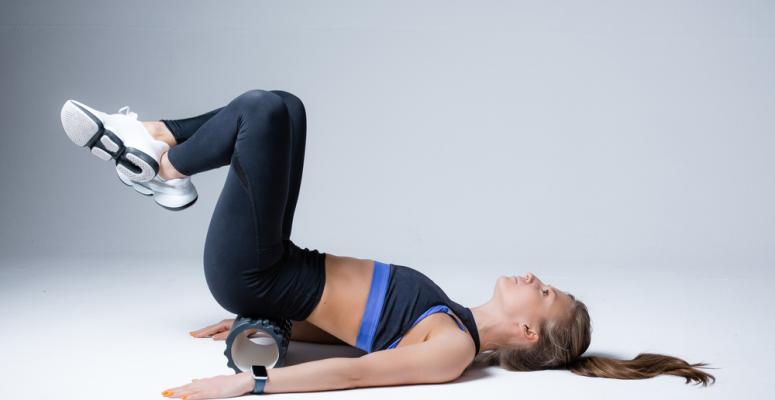
Lower back pain can have many causes. It can stem from an injury, surgery complications, or any number of conditions affecting your spine or hips.
Wherever your lower back pain stems from, a foam roller may be able to help. These polyethylene tools can help to loosen your muscles, ease soreness and reduce inflammation in your lower back region. Over time, working with a foam roller can increase the range of motion in your joints, which can lead to long-term pain reduction.
Below, we'll share five easy foam roller exercises for your lower back. While we always recommend that you visit a professional physical therapist for back pain treatment, you can use these exercises for temporary pain relief at home.
1. Supported bridge rolls
This is a 30-second exercise that helps to stretch out your lower back and abdominal muscles. Here's how you do it:
- Sit upright on the floor with the foam roller behind you perpendicular to your back.
- Place your hands on the floor behind you. Bend your elbows and lower yourself onto the roller. Keep your buttocks on the ground, allowing your upper back to bend over the roller.
- Lower your upper back down until your shoulders are on the ground. Stretch your arms out to the side.
- Rest for 30 seconds before returning to an upright sitting position.
2. Hip flexor release rolls
This is a 60-second exercise (30 seconds for each side of your body). It releases tension in the hip flexor muscles, which can be helpful as tight hip flexors often cause lower back pain.
- Lying flat on the ground, lift yourself with your legs and slide the roller under your lower back, just above your buttocks.
- Pull your right foot toward your body; then use your arms to pull it closer to your chest.
- Straighten your left leg outward (keep it flexible; don't lock your knee).
- Hold this position for 30 seconds; then return your right foot to the floor.
- Repeat with your left leg.
3. Lower back massage rolls
This stretch is designed to release tension in your lower back. Here's how you do it:
- Lying flat on the ground, lift yourself with your legs and slide the roller under your lower back, just above your buttocks.
- Pull both of your knees toward your chest with your hands.
- Rock your weight to one side, lifting your back off the foam roller on the other side. Hold for a few seconds; then switch sides.
- Repeat for 30 to 60 seconds.
4. Supported twists
This exercise is intended to stretch the hip flexors and lower back muscles. It can also help to improve flexibility in the spine.
- Ly on the foam roller so that it sits under your lower back, just above your buttocks. Place your feet flat on the ground
- Bring your right knee to your chest and stretch your left knee outward in front of you (keep your legs flexible; don't lock your knee).
- Straighten your right arm out to your right side and reach your left hand across your body so it touches your right knee.
- Pull your right knee across your body so that your back is twisted. Hold for 30 seconds; then release and repeat on your left side.
5. Glute rolls
This foam roller exercise supports your lower back by strengthening your gluteus maximus muscles. Here's how you do it:
- Sit on top of your foam roller with it sitting perpendicular to your body.
- Cross your right leg over your left knee. Keep your left knee flat to the floor.
- Rock your body side to side, rolling the foam roller across your glutes.
- Repeat for the other side of your body.
Important tip: Consider physical therapy for lower back pain
While foam roller exercises can be effective for lower back pain, they won't always help you achieve pain relief. Some lower back problems stem from muscles in the other parts of the body, such as the hips or shoulders.
Also, exercising with a foam roller isn't always the best option. If you perform and exercise incorrectly, it could worsen your problem and cause your further pain.
A physical therapist will evaluate your symptoms and determine the source of your lower back pain. They will then design a treatment plan to alleviate your specific symptoms. This treatment plan could include foam roller exercises for your lower back, but it may also include myofascial release, dry needling or any number of other methods.
Alliance PTP is ready to help you find top-notch PT for lower back pain
At Alliance Physical Therapy Partners, we're proudly bringing together physical therapy practices across the country to help people get the high-quality PT they need. Want to see a physical therapist in person? We can put you in touch with an Alliance PTP partner that's close to you and that can help you address lower back pain.
Not keen on in-person PT sessions or not close to an Alliance PTP partner? No worries. We also offer effective and affordable virtual physical therapy through our Agile Virtual Physical Therapy platform.
Contact our team today so we can help you find the most effective physical therapy services for your injury or condition.
Get Help at a Location Near You
